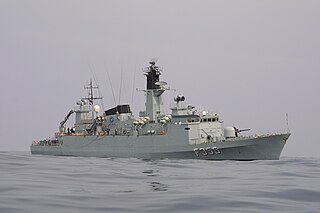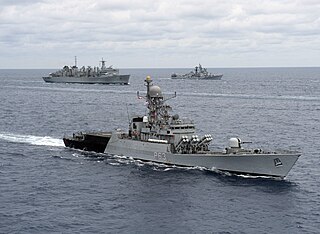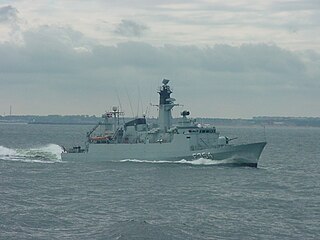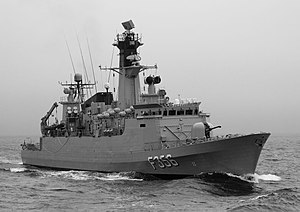
The Royal Danish Navy is the sea-based branch of the Danish Armed Forces force. The RDN is mainly responsible for maritime defence and maintaining the sovereignty of Danish territorial waters. Other tasks include surveillance, search and rescue, icebreaking, oil spill recovery and prevention as well as contributions to international tasks and forces.

Peter Jansen Wessel Tordenskiold, commonly referred to as Tordenskjold, was a Norwegian nobleman and flag officer who spent his career in the service of the Royal Dano-Norwegian Navy. He rose to the rank of vice-admiral for his services in the Great Northern War. Born in the Norwegian city of Trondheim, Peter Wessel travelled to Copenhagen in 1704 and eventually enlisted in the navy.

The Delhi-class destroyers are guided-missile destroyers of the Indian Navy. Three ships of this class are in active service. The Delhi-class vessels were the largest vessels to be built in India at the time of their commissioning. The ships were built by Mazagon Dock Limited (MDL) at a cost of ₹750 crore each.

The RIM-116 Rolling Airframe Missile (RAM) is a small, lightweight, infrared homing surface-to-air missile in use by the German, Japanese, Greek, Turkish, South Korean, Saudi Arabian, Egyptian, Mexican, UAE, and United States navies. It was originally intended and used primarily as a point-defense weapon against anti-ship missiles. As its name indicates, RAM rolls as it flies. The missile must roll during flight because the RF tracking system uses a two-antenna interferometer that can measure phase interference of the electromagnetic wave in one plane only. The rolling interferometer permits the antennas to look at all planes of incoming energy. In addition, because the missile rolls, only one pair of steering canards is required. As of 2005, it is the only U.S. Navy missile to operate in this manner.

The OTO Melara 76 mm gun, being marketed as the OTO 76/62 Gun Mount, is a naval autocannon built and designed by the Italian defence company OTO Melara. It is based on the OTO Melara 76/62C and evolved toward 76/62 SR and 76/62 Strales.

HDMS Olfert Fischer (F355) was a Niels Juel-class corvette of the Kongelige Danske Marine. The vessel was laid down in December 1978 and commissioned in October 1981. The corvette operated in the Persian Gulf on two occasions, first in 1990 and 1991 as part of the multinational fleet enforcing the United Nations sanctions against Iraq, then again in 2003 in support of the United States-led invasion of Iraq. Olfert Fischer was deployed as part of the NATO Standing Naval Force Atlantic on at least four occasions during her career.

The Niels Juel class was a three-ship class of corvettes formerly in service with the Royal Danish Navy. They were built in Denmark at Aalborg Shipyard and were launched in the period 1978–1980. In 1998–2000 the three vessels had a mid-life update, as well as a large update on the electrical systems.

The Laksamana class is a class of small missile corvettes comprising four ships currently in service with the Royal Malaysian Navy. All four ships of the Laksamana class are currently serving in the 24th Corvette Squadron of the Royal Malaysian Navy.

The Jacob van Heemskerck-class frigate was a class of frigates of the Royal Netherlands Navy. They were designed to be an air defence version of the Kortenaer class. The helicopter was replaced by a Standard medium range surface-to-air missile (SAM) system and associated radars. Two ships were built for the Royal Netherlands Navy. In 2005 they were sold to the Chilean Navy.

The Iowa-class battleships are the most heavily armed warships the United States Navy has ever put to sea, due to the continual development of their onboard weaponry. The first Iowa-class ship was laid down in June 1940; in their World War II configuration, each of the Iowa-class battleships had a main battery of 16-inch (406 mm) guns that could hit targets nearly 20 statute miles (32 km) away with a variety of artillery shells designed for anti-ship or bombardment work. The secondary battery of 5-inch (127 mm) guns could hit targets nearly 9 statute miles (14 km) away with solid projectiles or proximity fuzed shells, and was effective in an anti-aircraft role as well. Each of the four battleships carried a wide array of 20 mm and 40 mm anti-aircraft guns for defense against enemy aircraft.

Kora-class corvettes are guided missile corvettes, in active service with the Indian Navy and the National Coast Guard of Mauritius. Four vessels were built at Garden Reach Shipbuilders and Engineers (GRSE) and outfitted at Mazagon Dock Limited (MDL).

On 29 November 1990, the adoption of United Nations Security Council Resolution 678 authorized the assembly of a multinational military coalition to fight against Iraq in the Gulf War. The coalition's purpose was to liberate Iraqi-occupied Kuwait by "all necessary means" if Iraq did not withdraw by 15 January 1991. Iraq failed to relinquish control over Kuwait by the deadline specified in Resolution 678, leading to the commencement of combat operations with the Gulf War aerial bombardment campaign on 17 January 1991. At this time, the coalition consisted of 42 countries and was spearheaded by the United States: the central command was led by the United States, Saudi Arabia, and the United Kingdom; the marine command was led by the United States; the Joint Forces East Command was led by Egypt, Saudi Arabia, Syria, Morocco, Kuwait, Oman, the United Arab Emirates, Qatar, Bahrain, Poland, and Czechoslovakia; and the Joint Forces North Command was led by the United States, the United Kingdom, France, Canada, Italy, Australia, Japan, and Turkey. On 23 February 1991, the aerial bombardment campaign came to an end as the coalition began a large-scale ground offensive into Iraqi-occupied Kuwait and parts of Iraq. The Iraqi military was devastated in the fighting, and Kuwait was declared completely free of occupying Iraqi troops on 28 February 1991.

The Freedom class is one of two classes of the littoral combat ship program, built for the United States Navy.

BALTOPS is an annual military exercise, held and sponsored by the Commander, United States Naval Forces Europe, since 1971, in the Baltic Sea and the regions surrounding it.
The following is a hierarchical outline for the Danish armed forces at the end of the Cold War. It is intended to convey the connections and relationships between units and formations. In wartime all Danish military units would have come under the joint West German/Danish NATO command Allied Forces Baltic Approaches (BALTAP). BALTAP was a principal subordinate command under the Allied Forces Northern Europe Command (AFNORTH). The commander-in-chief of (BALTAP) was always a Danish Lieutenant General or Vice Admiral, who had the designation Commander Allied Forces Baltic Approaches (COMBALTAP). In peacetime BALTAP had only a few communication units allocated and all other units remained under national command of West Germany's Bundeswehr and Denmark's Forsvaret.

HDMS Niels Juel (F354) was a Niels Juel-class corvette in the Royal Danish Navy which was in use until 1990. The ship was named after Niels Juel, a 16th-century Danish admiral.
A number of vessels of the Royal Danish Navy have borne the name Peter Tordenskjold, after Peter Tordenskjold.

HDMS Iver Huitfeldt (F361) is a Iver Huitfeldt-class frigate in the Royal Danish Navy. The ship is named after Iver Huitfeldt, a 17th-century Danish officer.



















